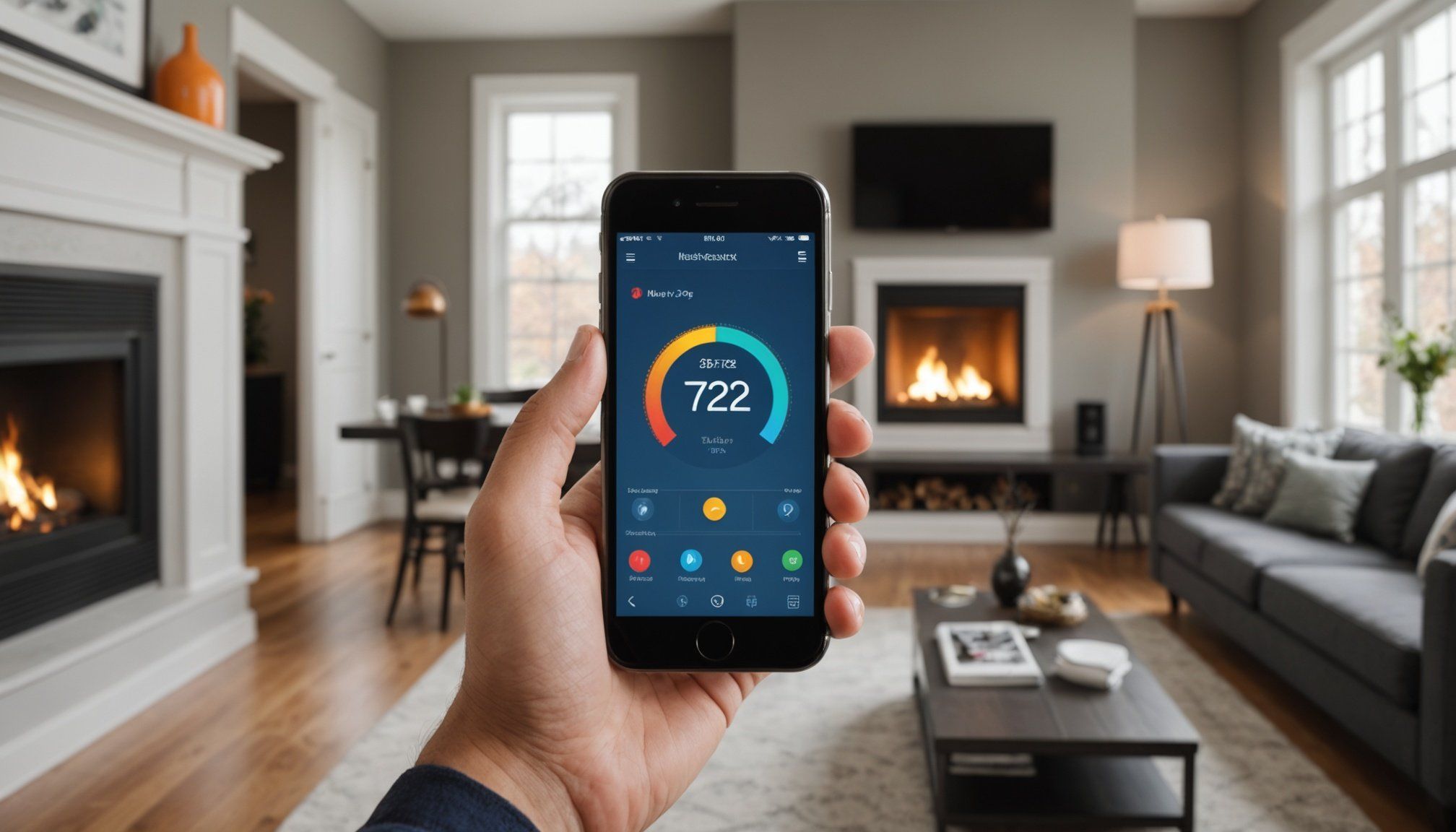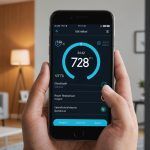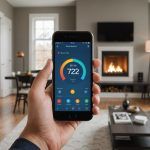Introduction to Smart Home Heating Systems
As homes leap into the future with smart home heating systems, integration is key. Today, temperature control technology merges seamlessly with the everyday convenience of smartphones. This synergy allows for personalized, real-time adjustments to home climates, ensuring optimal comfort with ease.
Modern advancements focus heavily on the idea of zone temperature control. In older systems, a single thermostat dictated temperatures for an entire house. Now, smart systems empower users to manage individual rooms or zones independently. This precision not only enhances comfort but also promotes energy efficiency.
This might interest you : Take charge of your indoor atmosphere: effortless smart hvac control and monitoring via your smartphone
Let’s not forget the myriad benefits of heating system management through smart solutions. With mobile apps, users can remotely adjust settings, schedule heating around daily routines, and even receive insights into their energy consumption. Here’s why integrating smart heating into our lives makes so much sense:
- Enhanced comfort: Tailored temperatures in every room.
- Energy savings: More control translates to reduced energy bills.
- Convenience: Make adjustments from anywhere, anytime.
Ultimately, smart home heating is reshaping how we think about warmth and efficiency, making cozy, connected homes a reality.
Topic to read : Revolutionize room comfort: effortless temperature control and monitoring with smart thermostats through your smartphone
Benefits of Zone Temperature Control
Zone temperature control allows homeowners to manage heating in different areas of their home independently. This system optimises energy efficiency by directing heat only where needed, minimising waste. In homes with multiple zones, each room or floor can maintain its own climate, which means energy isn’t expended on heating unused spaces. You’ll notice reduced utility bills since you’re only paying for the warmth you use.
A key advantage of this method is that it offers customized heating. Each zone can be adjusted to a desired temperature, catering to varying preferences. For instance, one might prefer a cooler bedroom for sleeping and a warmer living room for relaxation. This flexibility adds a layer of comfort that centralized systems lack.
The benefits extend beyond cost savings and comfort; they also contribute to a sustainable lifestyle by lowering a household’s carbon footprint.
Incorporating zone temperature control systems into your home aligns with modern technological advances, making them convenient and practical to manage. Intelligent thermostats now offer remote control through mobile apps, allowing for seamless adjustments. Such systems not only enhance comfort but also tread lightly on the environment, making them a smart choice for today’s environmentally conscious homeowner.
Key Features of Smartphone-Enabled Heating Systems
Smartphone-enabled heating systems bring a new level of convenience and efficiency to home heating. One of the standout features of smart thermostats is their ability to aid in zone control. This means that homeowners can tailor the heating in different parts of their home according to their needs or preferences, optimizing energy use and comfort.
A key consideration is the compatibility with existing heating systems. Smart thermostats are designed to integrate seamlessly with most modern systems. The process involves checking system requirements and following straightforward installation guides usually provided with the thermostat. This ensures that users do not need to completely overhaul their current setup to enjoy the benefits of a smartphone controllable heating system.
Remote access is a major benefit. By utilizing mobile apps, users can adjust their heating preferences from virtually anywhere. Whether you’re returning home from a trip or adjusting settings while at work, these apps provide unmatched flexibility. This accessibility ensures consistent home comfort and the potential for energy savings, as heating can be adjusted on-the-go, eliminating unnecessary usage.
Such heating system features make it not only a technologically advanced option but also a practical investment in modern home automation.
Recommended Products for Smart Heating
Dive into the world of smart heating solutions to enhance comfort and efficiency at home. These smart tools offer precision and convenience in managing your home’s temperature.
Top Smart Thermostats
Smart thermostats have transformed home heating with their energy-saving capabilities and adaptability. Brands like Nest, Ecobee, and Honeywell offer advanced models that learn your schedule and preferences. These devices automatically adjust the temperature, ensuring optimal heating while reducing energy consumption.
Recommended Temperature Control Apps
Empower your smart thermostat with temperature control apps. These apps provide remote access to your heating system via your smartphone. Apps like Nest and Ecobee offer user-friendly interfaces to schedule heating, monitor energy use, and receive maintenance alerts. Discover the ease of adjusting your home’s climate to suit your lifestyle from anywhere.
Comparison of Heating System Brands
While several brands offer smart heating solutions, each has unique features. Nest focuses on learning algorithms to predict your needs, while Ecobee excels with integrated room sensors for balancing temperature across spaces. Honeywell delivers reliability with its easy integration into existing systems. Understand these differences to choose a system that best aligns with your requirements and priorities.
Explore these smart options to revolutionise your home heating experience with confidence and efficiency.
Setup Guide for Implementing Zone Control
Implementing zone control setup in your home can significantly enhance energy efficiency and comfort. If you’re considering this step, our installation guide simplifies the process. Start by ensuring compatibility with your existing heating system. Identify the zones you intend to control independently. Typically, each zone requires a thermostat.
Step-by-Step Instructions
To install, follow these:
- Disconnect power to prevent accidents.
- Attach the new zoning thermostat in each designated area.
- Connect wiring to each thermostat. Match the labels carefully to the existing system.
- Reconnect power and configure the control panel to recognize new zones.
Optimizing for Smart Home Integration
For homes integrated with smart solutions, evaluate compatibility with ecosystems like Alexa or Google Home. Update the system firmware regularly to leverage the latest features. Pair thermostats with your smartphone app to enable remote control.
Troubleshooting Common Issues
- Connectivity issues? Ensure Wi-Fi stability and correct password entries.
- Uneven heating/cooling? Check thermostat placements and recalibrate if needed.
- Unexpected power shutdowns? Verify that circuit breakers are not overloaded.
Consult a professional if complications persist beyond these common difficulties. With the proper steps and vigilance, zone control can transform your heating efficiency.
User Testimonials and Case Studies
User experiences and case studies offer invaluable insights into the effectiveness of heating solutions. Real-world examples demonstrate how homeowners have successfully implemented zone temperature control to maintain comfort while optimizing energy use.
One notable case study involves a family who integrated smart thermostats into their home. They reported experiencing precise zone temperature control, which allowed them to heat specific areas as needed. This strategy helped reduce waste and contributed to tangible energy savings. Users often highlight the ability to tailor heating solutions to their lifestyle as a primary benefit.
However, these implementations are not without challenges. Some users have noted difficulty in initially setting up their systems and ensuring compatibility with existing infrastructure. Despite these hurdles, the general consensus from reviews suggests that the long-term benefits outweigh the initial setup challenges.
Energy savings are a recurring theme in user testimonials. Many users have reported significant decreases in utility bills after adopting these smart heating solutions. By only consuming energy where and when it is needed, users can potentially lower costs without compromising comfort.
Overall, reading user reviews and case studies provides an excellent foundation for understanding the practical benefits and drawbacks of these modern heating solutions. They serve as a guide for new users looking to make informed decisions.
Energy Efficiency and Cost Savings
Improving the energy efficient heating of your home holds significant benefits. A statistical analysis reveals that implementing zone control systems can lead to substantial reductions in energy usage. For example, households adopting these systems can witness annual savings of up to 30% on heating costs compared to traditional systems. This reduction not only ensures a more sustainable footprint but also enhances your financial savings.
Beyond immediate heating cost reduction, investing in smart heating systems presents a compelling case for return on investment (ROI). Although upfront costs can be daunting, these systems often pay for themselves within a few years through energy savings alone. Evaluations detail that most users see an ROI period of approximately three to five years, depending on the size of their home and local climate.
When comparing heating costs before and after the implementation of modern systems, the differences are tangible. Prior to upgrading, many households report struggling with fluctuating and unpredictable bills. Post-implementation, costs typically stabilize, offering more predictable expenses. Investing in these systems not only tackles current financial efficiencies but also prepares households for long-term cost stability. Embracing energy-efficient technologies today ensures a more reliable, cost-effective tomorrow.
Future of Home Heating Technology
The future heating innovations are rapidly reshaping how we heat our homes, guided by smart home trends and emerging technologies. These advances promise not only to enhance comfort but also to improve energy efficiency, offering significant savings for homeowners.
In recent years, there has been a surge in smart heating technology. Devices and systems capable of learning your preferences and adjusting automatically represent a core trend. For instance, smart thermostats analyse usage patterns and weather forecasts to optimize heating schedules, effectively reducing energy use and costs without compromising comfort.
Zone control systems are also set to evolve significantly. Current innovations hint at systems that allow more precise and dynamic management of heating in different areas of the home. This could lead to increased control and efficiency, allowing homeowners to heat only areas in use, further reducing energy consumption.
Looking forward, we can expect an increase in energy-efficient heating solutions. These may include innovations in heat exchange technologies, enhanced insulation materials, and integration with renewable energy sources like solar panels. As these technologies continue to advance, they hold the potential to transform residential heating into a more sustainable and economical component of modern smart homes.











